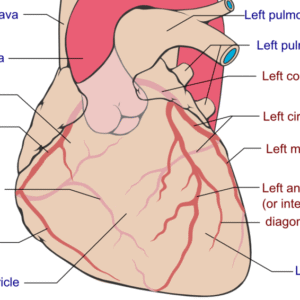Cardiology > Myocardial contusion
Myocardial Contusion
Background
Myocardial contusion refers to blunt trauma-induced injury to the myocardium, most commonly affecting the right ventricle due to its anterior position. It results from a sudden deceleration or impact force that compresses the heart against the sternum or spine, leading to myocardial hemorrhage, edema, necrosis, and potential arrhythmias or hemodynamic instability. Although often underdiagnosed, myocardial contusion can mimic acute coronary syndromes and cause significant morbidity if not recognized promptly.
Classification/Types
By Severity:
- Mild Contusion: Minimal myocardial bruising with transient ECG changes.
- Moderate Contusion: Myocyte necrosis, elevated cardiac enzymes, and arrhythmias.
- Severe Contusion: Associated with wall motion abnormalities, heart failure, or cardiac rupture.
By Location:
- Right Ventricular Contusion (most common)
- Left Ventricular Contusion (more severe hemodynamic impact)
- Atrial Contusion (less common, may cause conduction abnormalities)
By Mechanism:
- Direct Chest Impact (e.g., steering wheel, blunt trauma)
- Deceleration Injury (e.g., motor vehicle collisions, falls)
Pathophysiology
Blunt trauma results in a sudden compression of the heart between the sternum and vertebral column, causing microvascular injury, myocardial edema, and cellular necrosis. Inflammatory cascades and myocardial hemorrhage further impair myocardial function. Electrical conduction may be disrupted, resulting in arrhythmias. In severe cases, myocardial rupture, septal defects, or valvular damage can occur.
Epidemiology
- Occurs in up to 20% of patients with significant blunt chest trauma.
- Motor vehicle accidents are the leading cause.
- Right ventricle is involved in >50% of cases.
- Underdiagnosed due to non-specific clinical and ECG findings.
- Often coexists with rib fractures, sternal fractures, or pulmonary contusion.
Etiology
I) Causes
- Motor vehicle collision (dashboard or steering wheel impact)
- Falls from height
- Assault/blunt chest trauma
- Sports injuries (e.g., baseball, hockey puck to chest)
- Blast injuries or industrial accidents
II) Risk Factors for Complications
- Severe chest wall trauma
- Coexisting thoracic injuries (rib fractures, hemothorax)
- Hypotension or arrhythmia at presentation
- Elderly patients or those with preexisting cardiac disease
Clinical Presentation
I) Symptoms
- Retrosternal chest pain, often pleuritic or pressure-like
- Dyspnea or orthopnea
- Palpitations or lightheadedness
- Syncope or near-syncope in arrhythmia or tamponade
II) Signs
- Tachycardia or bradycardia
- Hypotension, especially with associated bleeding
- New heart murmur (suggests valvular injury)
- Jugular venous distension, muffled heart sounds (if tamponade)
- Chest wall tenderness, bruising, or crepitus
- ECG: ST changes, bundle branch block, PVCs, AV block
Differential Diagnosis (DDx)
- Acute coronary syndrome (ACS)
- Pulmonary contusion or embolism
- Aortic dissection
- Pericardial tamponade
- Cardiac tamponade from other causes
- Sternal fracture-related pain
- Myocarditis or pericarditis
Diagnostic Tests
Baseline/Monitoring
- ECG: Nonspecific ST-T changes, arrhythmias, conduction blocks
- Cardiac Enzymes (Troponin, CK-MB): Elevation indicates myocyte injury
- Transthoracic Echocardiography (TTE): Wall motion abnormalities, pericardial effusion
- Chest X-ray: May show rib/sternal fractures or widened mediastinum
- CT Chest: Assesses concurrent injuries; may detect myocardial contusion
- Cardiac MRI: Useful for identifying myocardial edema, hemorrhage, or fibrosis in uncertain cases
Serial Monitoring
- ECGs and cardiac enzymes over 24–48 hours in moderate to high-risk patients
- Continuous telemetry monitoring for arrhythmias
Treatment
I) Acute Management
- Monitoring: Continuous ECG and vital signs
- Oxygen and IV Fluids: For hypotension and hypoxia
- Pain Control: Opioids or NSAIDs with caution
- Arrhythmia Management: ACLS protocols for life-threatening arrhythmias
- Avoidance of Excessive Volume Loading: Especially if concern for tamponade or RV dysfunction
II) Long-Term/Definitive Therapy
- Supportive Care: Majority of mild cases resolve spontaneously
- Heart Failure Management: In cases with significant wall motion abnormality or reduced EF
- Surgical Consultation: If tamponade, cardiac rupture, or septal/valvular injury suspected
- Cardiac Rehab and Risk Stratification: For patients with residual dysfunction
Medications
Purpose | Examples | Notes |
Antiarrhythmics | Amiodarone, Beta-blockers | For ventricular or supraventricular arrhythmias |
Analgesics | Morphine, Fentanyl | Avoid NSAIDs in suspected pericardial effusion |
Diuretics | Furosemide | In patients with pulmonary congestion |
Inotropes | Dobutamine (if needed) | For low-output states post-contusion |
Device Therapy (Related Considerations)
- Temporary Pacemaker: For high-grade AV block
- Defibrillator (ICD): Rarely needed unless persistent post-traumatic VT/VF
- Mechanical Ventilation: In patients with respiratory distress or pulmonary contusion
- Pericardiocentesis: If tamponade is present
Patient Education, Screening, Vaccines
- Educate on signs of arrhythmia, worsening dyspnea, or syncope
- Emphasize the need for follow-up cardiac imaging and evaluation
- Encourage cardiac rehab if post-contusion dysfunction persists
- Maintain updated vaccines, especially if hospitalization is prolonged
Consults/Referrals
- Cardiology: For echo interpretation and rhythm management
- Cardiothoracic Surgery: If tamponade, cardiac rupture, or structural injury
- Trauma Surgery: For associated injuries
- Intensive Care Unit: For severe contusions, arrhythmias, or hemodynamic instability
Follow-Up
Short-Term
- Monitor cardiac enzymes, serial ECGs
- Repeat echocardiography if symptoms persist or worsen
- Evaluate for arrhythmias or heart failure symptoms
Long-Term
- Cardiology follow-up for residual dysfunction
- Consider cardiac MRI in persistent dysfunction
- Holter monitor for subclinical arrhythmias
- Cardiac rehabilitation referral for recovery
Prognosis
- Mild myocardial contusions resolve without sequelae in most cases
- Mortality increases with delayed recognition, coexisting injuries, or complications such as tamponade
- Long-term prognosis depends on severity of injury and promptness of intervention
- With proper monitoring and supportive care, most patients recover fully
Stay on top of medicine. Get connected. Crush the boards.
HMD is a beacon of medical education, committed to forging a global network of physicians, medical students, and allied healthcare professionals.

